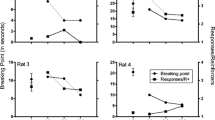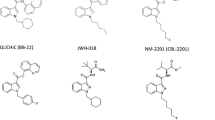Abstract
It has been reported that cannabidiol (CBD) antagonizes the effects of Δ9-tetrahydrocannabinol (THC) on operant behavior in rats and pigeons. We have replicated this finding with rhesus monkeys. Four rhesus monkeys were trained to lever press on a fixedinterval 5-min schedule of food presentation with a 1-min limited hold and 1-min time out between successive intervals. The effects of 0.3 and 1.0 mg/kg THC alone were determined three times during the experiment; before the CBD-THC interaction, after the CBD-THC interaction and once with the CBD vehicle. A dose of 30 mg/kg CBD, which alone resulted in a 24% reduction in responding, completely antagonized the response rate reduction produced by 0.3 mg/kg THC. The effects of THC revealed a rate-dependent effect that did not conform to the log-linear rate-dependency plots described for most other drugs.
Similar content being viewed by others
References
Alozie SO, Martin BR, Harris LS, Dewey WL (1980) 3H-Δ9-Tetrahydrocannabinol, 3H-cannabinol and 3H-cannabidiol: Penetration and regional distribution in rat brain. Pharmac Biochem Behav 12:217–221
Brady KT, Balster RL, Meltzer LT, Schwertz D (1980) Comparison of phencyclidine and three analogues on fixed-interval performance in rhesus monkeys. Pharmac Biochem Behav 12:67–71
Borgen LA, Davis WM (1974) Cannabidiol interaction with Δ9-tetrahydrocannabinol. Res Commun Chem Pathol Pharmacol 7:663–670
Carlini EA, Santos M, Claussen U, Bienick D, Korte F (1970) Structure-activity relationships of four tetrahydrocannabinols and the pharmacological activity of five semi-purified extracts of cannabis sativa. Psychopharmacologia 18:82–93
Carney JM, Uwaydah IM, Balster RL (1977) Evaluation of a suspension system for intravenous self-administration studies of water-insoluble compounds in the rhesus monkey. Pharmacol Biochem Behav 7:357–364
Davis W, Borgen L (1974) Effects of cannabidiol and Δ9-tetrahydrocannabinol on operant behavior. Res Commun Chem Pathol Pharmacol 9:453–462
Dews PB, Wenger GR (1977) Rate-dependency of the behavioral effects of amphetamine. In: Thompson T, Dews PB (eds) Advances in behavioral pharmacology, Vol I. Academic Press, New York, p 167
Ford RD, Balster RL, Dewey WL, Beckner JS (1977) Δ9-THC and 11-OH-Δ9-THC: Behavioral effects and relationship to plasma and brain levels. Life Sci 20:1993–2004
Frankenheim JM, McMillan DE, Harris LS (1971) Effects of 1-Δ9- and 1-Δ8-transtetrahydrocannabinol and cannabinol on schedule-controlled behavior of pigeons and rats. J Pharmacol Exp Ther 178:241–252
Fry W, Kelleher RT, Cook L (1960) Mathematical index of performance on fixed-interval schedules of reinforcement. J Exp Anal Behav 3:193–199
Gonzalez FA, Byrd LD (1977) Mathematics underlying the rate-dependency hypothesis. Science 195:546–550
Grisham MG, Ferraro DP (1972) Biphasic effects of Δ9-tetrahydrocannabinol on variable-interval schedule performance in rats. Psychopharmacologia 27:163–169
Grlic L (1962) A comparative study on some chemical and biological characteristics of various samples of cannabis resin. Bull Narcot 14:37–46
Harris LS, Dewey WL, Razden RK (1977) Cannabis. Its chemistry, pharmacology and toxicology. In: Martin WR (ed) Drug addiction II. Springer, Berlin Heidelberg New York, p 371
Herrnstein RJ, Morse WH (1957) Effects of pentobarbital on intermittently reinforced behavior. Science 125:929–931
Hollister LE, Gillespie H (1975) Interactions in man of delta-9-tetrahydrocannabinol II. Cannabinol and cannabidiol. Clin Pharmacol Ther 18:80–83
Jarbe TUC, Henriksson BG, Ohlin GC (1977) Δ9-THC as a discriminative cue in pigeons: Effects of Δ8-THC, CBD, and CBN. Arch Int Pharmacodyn Ther 228:68–72
Jones G, Pertwee RG (1972) A metabolic interaction in vivo between cannabidiol and Δ1-tetrahydrocannabinol. Br J Pharmacol 45:375–377
Karniol IG, Carlini EA (1972) The content of (-)-Δ1-transtetrahydrocannabinol (Δ9-THC) does not explain all biological activity of some Brazilian marihuana samples. J Pharm Pharmacol 24:833–835
Karniol IG, Carlini EA (1973) Pharmacological interaction between cannabidiol and Δ9-tetrahydrocannabinol. Psychopharmacologia 33:53–70
Karniol IG, Shirakawa I, Kasinski N, Pfeferman A, Carlini EA (1974) Cannabidiol interferes with the effects of Δ9-tetrahydrocannabinol in man. Eur J Pharmacol 28:172–177
Kelleher RT, Morse WH (1968) Determinants of the specificity of behavioral effects of drugs. Ergebnisse der Physiologie 60:1–56
Kosersky DS, McMillan DE, Harris LS (1974) Δ9-tetrahydrocannabinol and 11-hydroxy-Δ9-tetrahydrocannabinol: Behavioral effects and tolerance development. J Pharmacol Exp Ther 189:61–65
Levy S, McCallum N (1975) Cannabidiol and its pharmacokinetic interaction with Δ1-tetrahydrocannabinol. Experientia 31: 1268–1269
McMillan DE (1977) Behavioral pharmacology of the tetrahydrocannabinols. In: Thompson T, Dews PB (eds) Advances in behavioral pharmacology, vol I. Academic Press, New York, p 1
Mechoulam R (1970) Marhuana chemistry. Science 168:1159–1166
Paton WDM, Pertwee RG (1972) Effects of cannabis and certain of its constituents on pentobarbital sleeping time and phenazone metabolism. Br J Pharmacol 44:250–261
Siemens A, Kalant H, deNie (1976) Metabolic interaction between Δ9-tetrahydrocannabinol and other cannabinoids in rats. In: Braude MC, Szara S (eds). Pharmacology of marihuana, vol I. Raven Press, New York, p 77
Topp G, Dallmer J, Schou J (1976) Changes in metabolism of Δ9-tetrahydrocannabinol caused by other cannabis constituents. In: Nahas G (ed) Marihuana: chemistry, biochemistry and cellular effects. Springer, Berlin Heidelberg New York, p 187
Turkanis SA, Cely W, Olsen DM, Karler R (1974) Anticonvulsant properties of cannabidiol. Res Commun Chem Pathol Pharmacol 8:231–246
Wayner MJ, Greenberg I, Fraley S, Fisher S (1973) Effects of Δ9-tetrahydrocannabinol and ethyl alcohol on adjunctive behavior and the lateral hypothalamus. Physiol Behav 10:109–132
Author information
Authors and Affiliations
Additional information
This research was reported at the FASEB Meeting in Atlantic City, NJ in 1978 [Fed. Proc. 37: 739 (Abs.) 1978]
Rights and permissions
About this article
Cite this article
Brady, K.T., Balster, R.L. The effects of Δ9-tetrahydrocannabinol alone and in combination with cannabidiol on fixed-interval performance in rhesus monkeys. Psychopharmacology 72, 21–26 (1980). https://doi.org/10.1007/BF00433803
Received:
Accepted:
Issue Date:
DOI: https://doi.org/10.1007/BF00433803




